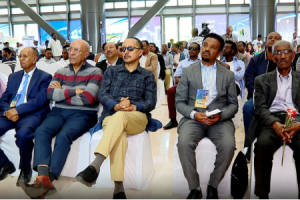
Addis Ababa was founded as the official capital city of Ethiopia in 1886 during Emperor Menilik II. As 2008 Ethiopian Statistical Agency report, it became the home of 3.5 million Nations, Nationalities and Peoples of Ethiopia. Besides, it is the largest, commercial and political capital of Ethiopia and it is the home of African Union (AU), the Economic Commission for Africa (ECA), 118 embassies and other continental and international organizations. Due to this reason, it is known as diplomatic capital of Africa. Addis is taken as the third diplomatic city in the world. Therefore, it doesn’t not come as a surprise if it attracts tourists from different parts of the world.
According to the Addis Ababa City Government Culture and Tourism Bureau, the city is becoming popular in hosting conference tourism. Thus, tourists who come for conference and other purposes get ample opportunities to visit remarkable natural and manmade tourist attractions of the city. There are mesmerizing monuments, palaces, churches, mosques, museums, mountains, hotels and cultural heritages in Addis Ababa.
Worku Mengesha, Communication Directorate Director at the city’s Culture and Tourism Bureau told The Ethiopian Herald that the natural and manmade tourist attractions entitled Addis as “the rising city” in luring tourists and in hosting them friendly and warmly.
‘‘Regarding natural sites, Enteto landscape is very attractive that anyone would veiw 70 percent of the city standing at a top of the mountain. Viwers will have unforgettable time enjoying fresh air. The other very interesting tourist site that every tourist would be eager to visit is the Gulele Botani Garden.
The garden consists various endemic animals, birds and plant species,’’ he notes, adding: ‘‘Since Ethiopia has more than three thousand years of history, there are historical heritages such as monuments, museums, ancient palaces, churches and mosques. There are 17 monuments in the city. All of the monuments have historical significance.’’
Among the 17 monuments which are found in Addis, the monument of Emperor Menelik II is the most notable which is visible at the center of the city in front of St.George cathedral. The monument was erected in 1923 to commemorate the wise leadership of Emperor Menelik II who mobilized Ethiopians to fight the Italian colonialist power in the battle of Adwa in northern Ethiopia.
‘‘Our forefathers have defeated the then superpowers fighting round the clock with outdated weapons. They became the only black people in history that crashed European colonialists. Since then, Ethiopia has been seen as a beacon of freedom and resistance by black people. That is why many African nations replicated the colors of the Ethiopian flag in their respective national flag,’’ he pointed out.
The martyr’s memorial monument is another tourist attraction which is located in Sidist Kilo, in front of Yekatit 12 hospital. The monument was built to remember those 30,000 Ethiopians who were mercilessly massacred by Rudolfo Graziani following the suicide attempt. The other monument is the victory monument located at Arat Kilo. The monument was erected to remember Patriots’ Victory Day for those Ethiopians who have claimed victory against Italian invaders in the 6th April of 1941. The monument of Abune Petros who fought the Italians and Emperor Hailesslassie’s Lion monument are also among the astonishing monuments in Addis Ababa.
Moreover, Addis has historic theatre halls and museums. There are 13 museums in Addis Ababa. These include National Museum, Enteto Mariam Museum, Addis Ababa Museum, Ethnographic Museum, Natural Science Museum and Red Terror Memorial Museum. These museums hold many breathtaking historical and cultural heritages that could amuse tourists.
‘‘The museums embrace heritages which reflect the history and culture of Nations, Nationalities and Peoples of Ethiopia. For instance, anyone can visit the 3.5 million years old human ancestor known as Lucy or Australopithecus Afarensis discovered in Afar state. In addition to this, ancient manuscripts, crosses, royal clothes, household utensils and other heritages are found in the museums,’’ the Director notes. As far as ancient hotels and royal homes are concerned, the city has 400 historic royal homes being registered as tour sites. The extraordinary Taitu Betul Hotel named after the patriot Empress Taitu (the wife of Emperor Menelik II) catches the eye of many tourists.
Though it is more than 100 years old, it is still providing service to its customers in a very splendid manner.
Furthermore, Addis owns Africa’s largest open-air market commonly known as Merkato. The Italian word Merkato means market. The market consists of every goods that run the gamut from souvenirs to electronic gadgets, from cloths to machineries, from spice to cereals etc. You can get everything in the vast market. Besides, the city has suitable air condition and delicious traditional and foreign foods and drinks.
So far, Ethiopia has inscribed 11 heritages in UNESCO list. Timiket and Mesqel are among them. Many tourists flow to Addis ever year to witness the colorful celebration of these festivities. Nibret Kebede is a tourist guide, whose permanent residence is in Addis.He explains how much foreigners are engrossed by Ethiopian cultural festivals.
‘‘The tourists I have come across proved to be very happy by the incredible Timeket and Mesqel celebrations. They watch it in an extreme amusement. When they come back to their country, they share their memories and initiate others to visit as Addis and other parts of our country as well,’’ he stated.
Regarding the skill and logistics of tour and travel operators, Nibret urges the governmental and private institutions should strive to provide capacity building trainings for those who want to involve in hotel and tourism sector.
Though many task remain to be done, the average stay of tourists in Ethiopia is 14 days which is better than neighboring countries like Kenya, according to Worku Mengesha.
‘‘The tourists engage in plenty of tourist attractions across the country. They don’t want to come back to their countries without watching most of the known tourist destinations. Due to this reason, they would be obliged to stay more days. Apart from brand hotels, there are sufficient star hotels which could satisfy the needs of tourists,’’ he explained.
Approached for his say on hotel and tourism development in Addis, Lion Ethiopia and Hotel College Dean Zerihun Moknen said that there is improvement in producing qualified and technologically updated manpower that is capable of transforming the sector to a higher level.
‘‘The tourism sector has been facing challenges related with lack of sufficient and competent professionals, lack of vibrant researches and continuous and professional support which could help to provide essential input for modernizing the sector. Having understood this gap, hotel and tourism training colleges like ours are endeavoring to produce competent and skilled human power to the flourishing hotel and tourism market,’’ Zerihun stated.
To sum up, Addis Ababa has many blessings. However, it has not been utilizing its potential due to lack promotion and expansion of tourist destinations. Hence, the Ministry Culture and Tourism, Addis Ababa Culture and Tourism Bureau and pertinent stakeholders should work hand in hand to expolite the tourism blessings. If so, Addis will bloom new flower as its name.
Herald December 16/2018
BY TSEGAY HAGOS





